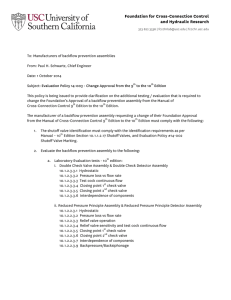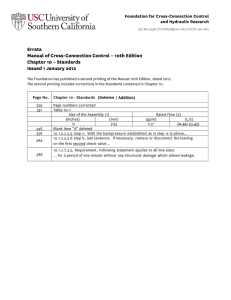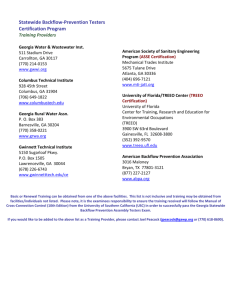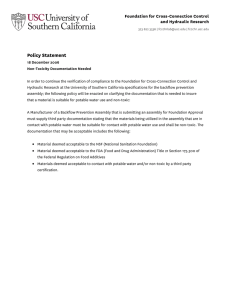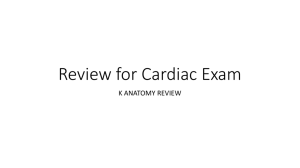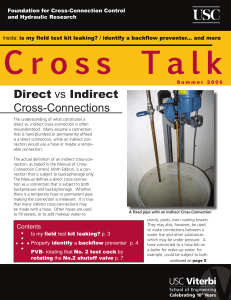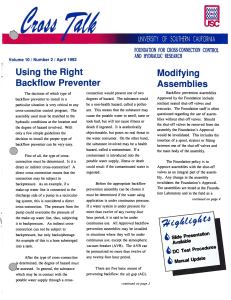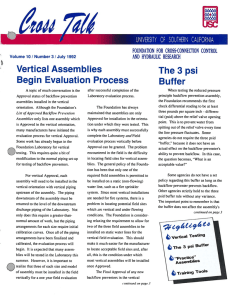Ninth Edition of Manual AND HYDRAULIC RESEARCH
advertisement
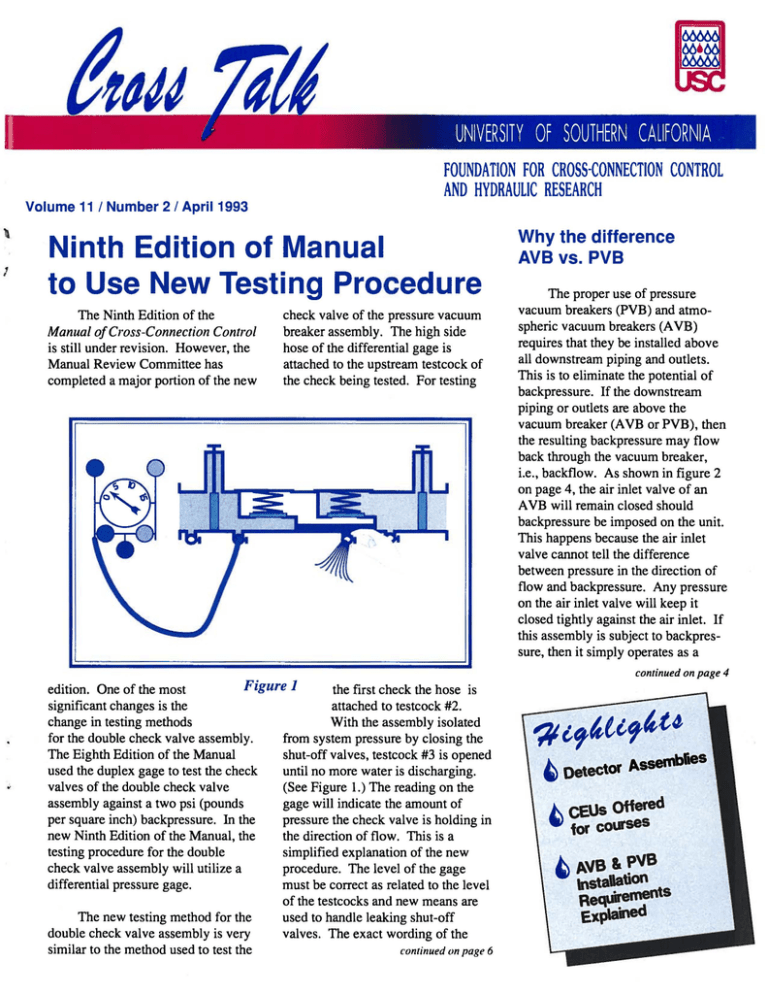
FOUNDATION FOR CROSS-CONNECTION CONTROL AND HYDRAULIC RESEARCH Volume 11 I Number 2 I April 1993 l Ninth Edition of Manual to Use New Testing Procedure The Ninth Edition of the Manual of Cross-Connection Control is still under revision. However, the Manual Review Committee has completed a major portion of the new check valve of the pressure vacuum breaker assembly. The high side hose of the differential gage is attached to the upstream testcock of the check being tested. For testing Why the difference AVB vs. PVB The proper use of pressure vacuum breakers (PVB) and atmospheric vacuum breakers (AVB) requires that they be installed above all downstream piping and outlets. This is to eliminate the potential of backpressure. If the downstream piping or outlets are above the vacuum breaker (AVB or PVB), then the resulting backpressure may flow back through the vacuum breaker, i.e., backflow. As shown in figure 2 on page 4, the air inlet valve of an A VB will remain closed should backpressure be imposed on the unit. This happens because the air inlet valve cannot tell the difference between pressure in the direction of flow and backpressure. Any pressure on the air inlet valve will keep it closed tightly against the air inlet. If this assembly is subject to backpressure, then it simply operates as a continued on page 4 Figure 1 edition. One of the most significant changes is the change in testing methods for the double check valve assembly. The Eighth Edition of the Manual used the duplex gage to test the check valves of the double check valve assembly against a two psi (pounds per square inch) backpressure. In the new Ninth Edition of the Manual, the testing procedure for the double check valve assembly will utilize a differential pressure gage. The new testing method for the double check valve assembly is very similar to the method used to test the the first check the hose is attached to testcock #2. With the assembly isolated from system pressure by closing the shut-off valves, testcock #3 is opened until no more water is discharging. (See Figure 1.) The reading on the gage will indicate the amount of pressure the check valve is holding in the direction of flow. This is a simplified explanation of the new procedure. The level of the gage must be correct as related to the level of the testcocks and new means are used to handle leaking shut-off valves. The exact wording of the continued on page 6 ~ ' "'''tt''t4 Detector Assembles ~ CEUs Offered tor c()l.WS8S ~ AVB & ~VB 1nstalati00 __ .a.ornents R~-·--; Ex~ 2 ®t~(j)(!}»~..New Members Quite a large number of agencies and companies decided to join the Membership program of the Foundation in the first quarter of 1993. With the Memberships continued growth, the Foundation is constantly seeking to serve the Member better. Members should contact the Foundation office with any ideas they may have. The following are those which joined the ranks of the Membership Program in the first quarter of this year. A B.E.S.T. Service Aqua-Tech Backflow Prevention Black & Veach Cambria Community Services District Castle Rock, Town of Citizens Utilities Company Corona Plumbing Cross-Connection Control of Arizona Tester Course Las Vegas, NV 12 -16 April 1993 The Foundation Laboratory 10 - 14 May 1993 12- 16 July 1993 4 - 8 October 1993 Incline Village, NV 2 - 6 August 1993 Non-Members $750.00 Members $600.00 ECS Company El Capitan Mutual Water Company Globe, City of Hammerquist and Associates Lawrence Livermore National Laboratory Lohrbach, Jon Matte, Dennis Mirage Horticulture Dept. Program Specialist Course Las Vegas, NV 19-23 Aprill993 Seattle, WA 21- 25 June 1993 USC Campus 19 -23 July 1993 North Georgia Consulting Northfield Mount Herman School Ohio Operator Training Committee Paris Utility District Plumber's Local Union #299 RAB Services, Ltd. Ray 0. Cook Co., Inc. Reese Mechanical Contractors Rosamond Community Services Dist. Roto-Rooter Plumbing Service Sanger, City of School District #35 (Langley) Southwest Backflow Specified Process Equipment Co. St. Joseph's Medical Center Thomas, James J. Water Training International Wayne Howard and Associates Winters, City of Non-Members $800.00 Members $640.00 Courses may be added throughout the year. Please contact the Foundation office for infonnation on courses in your area or for an application for the next USC Training Course. You may also send a hard copy of a purchase order or a check to the Foundation office to reserve a space. Please be advised that some of these courses fill six to eight weeks in advance. Foundation for Cross-Connection Control and Hydraulic Research University of Southern California KAP-200 University Park MC-2531 Los Angeles, California 90089-2531 (213) 740-2032 A Purchase Order may also be sent via FAX to the Foundation office at (213 ) 740-8399 Cross Talk i publ i hed by the University of Southern California's Foundation for CrossConnection Control and Hydraulic Research for its Members. Additional Copies are available to the Members upon request. (213) 740-2032 Copyright 1993 © University of Southern Cal iforn ia. All rights reserved. " 3 New Phone Number at the Lab The Foundation Laboratory has a new phone number. The old phone number is being phased out. When calling the Laboratory, please use the new number (213) 953· 8738. The FAX number at the lab will remain the same (213) 665·2055. Most of the time a Member of the Foundation's Engineering Staff can be reached at the Foundation Office. However, with the amount of short courses offered by the Foundation, some of the Engineers may be on the road teaching a class. In these cases a staff member should be at the Laboratory to answer any technical questions Members may have. When seeking information on Foundation short courses or materials offered by the Foundation (i.e., Slides, Videos, Manuals, etc.) please call the Foundation Office. The Essentials of CrossConnection Control A Graphic Slide Presentation Foundation Office (213) 740-2032 FAX (213) 740-8399 Foundation Lab (213) 953-8738 FAX (213) 665-2055 Cross-eonnection Control Informational Brochures The informational brochure entitled Working Together f or Saf e Water is a great complement to the slide presentation The Essentials of Cross-Connection Comrol. You'll be able to explain all the concepts of cross-connection control to your audience using the slide presentation. Then you can hand out the brochure. Thi gives those in attendance something to take with them which will help them to comprehend full y the topics discussed. The brochures come with the name, address and telephone number of the ordering agency, so those who desire more information or have questions, can call you directly. •. This brochure can be used to explain the basic concepts of cross-connection control, helping water users understand why they may need to install a backflow preventer or comply with periodic testing requirements. To request a sample of the brochure with an order form, contact the Foundation office at: Foundation for Cross-Connection Control and Hydraulic Research University of Southern California KAP-200 University Park MC-253 1 Los Angeles, CA 90089-253 1 (2 13) 740-2032 FAX (2 13) 740-8399 Working Together For Safe Water This set of sixty color graphic slides can be used for any length or type of presentation. The slides come with a three-ring binder which includes explanations of each slide. Your own photographic slides can be added at the appropriate points to help explain certain details or to relate theoretical concepts to specific local situations. For shorter presentations, slides can be removed so you can cover only the information you want to convey in the time allotted. Member Price $100 Non-Member Price $135 4 AVB vs. PVB, 6-inches vs. 12-inches continued from page 1 piece of piping with no potential to prevent backflow. The scenario is the same with the pressure vacuum breaker should the check valve become fouled. The elevation requirement has been confusing to some people since the AVB must be installed six (6) inches above the downAir stream Inlet piping and Float outlets, while the requirement for thePVB is twelve (12) practical level of performance. To provide a safety margin for actual field use, this level was then doubled to six (6) inches. This is the elevation requirement now stated in most codes and regulations for the atmospheric vacuum breaker. valve seat inside the unit. If the critical level is not noted on the unit, then it is recommended that the bottom of the unit be used as the reference point. This will assure that the minimum elevation requirements are maintained. The PVB differs from the AVB in that the PVB can be used under continuous pressure. TheA VB is only designed for noncontinuous use, (use during twelve of It is also important to note that the elevation requirement is above all downstream piping. In older codes wording was used requiring the vacuum breaker to be above the last sprinkler head or outlet. In some cases the requirement was for installation to be above a sufficient number of sprinkler heads. Most current codes use the wording "above all downstream piping and outlets" or a statement to the same effect. This is critical because of the backpressure which can build up due to the elevation of piping downstream of the assembly. inches. Many people ask why there Normal Flow Backpressure is a difference. To explain the basis for this difference, a any twenty-four Figure 2 review of some of the laborahour period). tory tests which an A VB or Due to the PVB being PVB must complete is in order. under continuous pressure, the safety factor was inIn the Foundation's Manual of creased by requiring the field Cross-Connection Control-Eighth installation height of twelve Edition, Section 10.2.5.3. the AVB (12) inches above all downmust undergo a test which entails stream piping and outlets. fouling the check seat with a specifiThe PVB must undergo the cally sized wire, then applying a same suction-rise test as vacuum condition to the inlet of the noted above for the AVB. unit. On the outlet of the A VB is a clear tube which extends down into a In considering the six vessel of water. See Figure 3. When inch and twelve inch elevathe vacuum is applied, the water in tions, it is also important to the clear tube may only rise a maxiknow where the measuremum of three inches. Should it rise ments are taken from. The more than three inches, this is cause critical level of an AVB or for rejection. The establishment of PVB may be shown on the the three inch level was experimenoutside of the unit. The critical level tally derived many years ago as a normally is at the level of the check Figure3 5 Detector Assemblies The double check detector assembly (DCDA) and the reduced pressure principle detector assembly (RPDA) are used in situations where the degree of hazard calls for either a double check valve assembly (DC) or a reduced pressure principle assembly (RP) with the additional requirement of detecting leaks or unauthorized use of water. These are normally found on fire sprinkler lines where the line is not metered for firefighting purposes. The detector assemblies contain a line sized backflow preventer along with a bypass which includes another backflow preventer of the same type (DC or RP). A common mistake is to change a DC or RP into a DCDA or RPDA, respectively, in the field by simply adding a by-pass line which includes a water meter along with a backflow preventer. This is not an acceptable practice for one simple reason; in the vast majority of cases, it will not work. The detector assemblies Approved by the Foundation must be carefully matched to allow all of the water at low flows (up to at least three gallons per minute) to flow through the bypass arrangement. This means that the pressure loss through the mainline assembly must be greater than the pressure loss through the bypass arrangement at these flow levels. The manufacturer carefully selecti the proper components to allow the correct hydraulic conditions to exist. In most cases if a stock mainline double check valve assembly is fitted with a bypass arrangement including a stock double check valve assemble and a water meter, the water meter will not register at any flow rate. The same is true for the RPDAs. One problem many agencies encounter is the fact that the meters on the bypass line are never read. If the meters are not to be read, then Double Check Detector Assembly there is no real reason to require a detector assembly on the fire sprinkler line. An appropriate backflow preventer for the degree of hazard at hand would be adequate. Many agencies in order to make it easier for the meter reader to read the meter on the detector assemblies have the meter piped up or over to a more convenient location. However, this additional piping can very easily increase the pressure loss through the bypass arrangement. This upsets the carefully designed balance of the complete assembly and may cause the water to flow exclusively through the main line at all flow rates, thus rendering the bypass arrangement useless. If an agency has such modified assemblies in the field, a simple way to determine if the meter on the bypass arrangement is operating is to open the #4 testcock of the mainline backflow preventer. If the meter registers, it does not prove that the detector is working properly since it has not been determined that the meter is registering accurately. However, it does show that the meter will register when low flows are used and alert the agency to determine the purpose of the unmetered water being used. If, when the #4 testcock is opened, the meter does not register at all, this is a clear indication that the modifications made have rendered the detector assembly useless for the purposes of detecting leaks and unauthorized uses of water. It does not, however, mean that the assembly will not prevent backflow. As long as both the mainline backflow preventer and the bypass backflow preventer are in good working order, the detector assembly will prevent backflow. In the situation where backflow protection is needed as well as detector capabilities it is strongly recommended that the agency require an Approved double check detector assembly or reduced pressure principle detector assembly. The Foundation's List of Approved Backflow Prevention Assemblies not only lists several of each of these assemblies which are Approved, but it also shows which assemblies shall be included in the bypass arrangement. This gives the agency the ability to determine if the assembly was possibly "field assembled." Additionally, the Foundation's List shows all of the various water meters which may be used with each of the detector assemblies without affecting the operational characteristics of the assembly. 6 Changes in the Ninth Edition of the Manual continued from page 1 testing and troubleshooting is still being finalized. how the gage should be attached and which valves are used in each procedure. Additionally, the test has been clarified somewhat to remove any misunderstandings which may be encountered by the tester. Manual. The Manual Review Committee has accepted the proposal and the integration of the drawings with the updated test procedures of Section 9 is now underway. One other major change in Section 9 of the Manual of CrossConnection Control is the inclusion Section 10 of the Manual covers of drawings to simplify the the specifications for backflow understand-ing of the testing prevention procedures. assemAlmost blies. It is every step the policy of the of the procedures for the Manual Review double Commitcheck valve tee to assembly, allow the manufacreduced turers of pressure the principle backflow assembly prevention and the assemblies pressure lh: Open the high side control needle valve approximately one tum, and then to comvacuum open the low side control needle valve no more than one-quarter (1/4) tum to byment on breaker pass water from the #2 testcock to the #3 testcock. If the low side control needle assembly this valve must be opened more than one-quarter (1/4) tum, to lower the differential Section will have pressure reading to the relief valve opening point, then see Troubleshooting before the an image Section 9.2.4.2- Instructions for leaking No.2 Shut-Of!Valve. Manual indicating exactly goes to which hose print. The 1i: Observe the differential pressure reading as it slowly drops to the relief valve is to be purpose of opening point (i.e., discharge of water from the relief valve). Record this opening attached to this is to point value when the first discharge of water is detected. which assure that testcock it will be lj: Close the low side control needle valve. and which technologically valve possible to should be comply with the new specifications in turned for each step. This will help The Foundation has been using a timely manner. In some cases, the those using the test procedures to illustrated testing procedures along requirements for specific items may understand the exact mechanics of with the Manual of Cross-Connection the test which is presented. The be delayed for a year or so in order to Control in its tester courses offered over the last year. Feedback from the insert on this page is taken from the allow the manufacturers to implestudents has been very positive and, test procedures for the reduced ment. This was the case with the thus, resulted in the recommendation pressure principle assembly. These publication of the Seventh Edition of to the Manual Review Committee are the steps the tester uses to the Manual in 1985. Included in the determine the relief valve opening that these illustrations be included in Seventh Edition was the requirement point. The drawings show exactly Section 9 of the Ninth Edition of the for resilient seated shut-off valves continued on page 7 7 CEUs Offered for Training Courses Continuing Education Units are now available for the Foundation's Training Courses. The Short Course for the Training of Backflow Prevention Assembly Testers provides 2.4 Continuing Education Units (CEUs). The Short Course for the Training of Cross-Connection Control Program Specialists provides 3.5 CEUs. After participating in one of these courses, the student need only notify the Foundation to obtain a CEU certificate or a transcript detailing the CEUs earned. As can be seen by the training schedule on page two, the Foundation is offering several short courses this year. If you wish to participate in one of these courses, please contact the Foundation office for an application form. Should you be interested in hosting a course in your area, an outline of what is necessary can be obtained from the Foundation office. The hosting agency is permitted two registrants at no cost for their help in arranging the course location. Some Members have asked if it is possible to present a USC training course themselves, using Foundation training material. It should be noted that there are no "USC Certified Instructors." Only those courses presented by University Staff Members are considered USC courses and no others. The Foundation does not offer a course for instructors nor does it License or Certify others to teach any course. Currently, the Foundation offers two five day training courses. The Short Course for the Training of Backflow Prevention Assembly Testers is designed to train those attending in the intricacies of testing the double check valve assembly, the reduced pressure principle assembly, and the pressure vacuum breaker assembly. Almost all of the course time is spent in learning these procedures. However, some time is spent on general hydraulics and the concepts of backflow and cross-connection control. The Short Course for the Training of Cross-Connection Control Program Specialists is designed to train those attending in the various aspects of administering a cross-connection control program. This course is usually for those who are in charge of a cross-connection control program for a water agency, health department, or even a large private facility. governed by the local administrative authority. (local health or water agency). Many administrative authorities require the individual to demonstrate their competency through the means of a test. On the other hand some administrative authorities will accept certification from a third party. For information on what is required to practice as a tester or a specialist, the Member should contact their local administrative authority. If it is unclear as to whom should be contacted, it is usually best to start with the local health agency or the state health authority. The Program Specialist course includes information on policies and procedures for carrying out a crossconnection control program, Federal, State and Local regulations, record keeping, public relations, along with preparing for and conducting site surveys. Although this course may be beneficial to instructors, it is not the intent of the course to prepare those attending to teach any type of course. It does not make the attendee a "specialist in testing backflow preventers." This course only includes a cursory review of the backflow prevention assemblies, and mainly concentrates on the administrative duties of those involved in cross-connection control. Ninth Edition At the successful conclusion of either of these courses the student is offered a "Certificate of Completion" from the Foundation, which simply states that they have successfully completed the specified training course. Certification allowing one to practice as a tester or a specialist is continued from page 6 and testcocks. However, because manufacturers often purchase shutoff valves and testcocks in bulk quantities, the requirement was that all Approved assemblies utilize resilient seated shut-off valves and testcocks one year after the publication of the Seventh Edition. With most of the major work of the Ninth Edition being completed, a final schedule has been produced which calls for the publication of the Ninth Edition in August of this year. Although the process has been long and complicated, the new Ninth Edition promises to be well worth the wait. Members of the Foundation will automatically be sent a complimentary copy of the Manual as soon as it is received from the printer. Additional copies will be available to the Members at a 25% discount. Calendar tJI Evenl1 This calendar lists activities which the Foundation plans on participating in over the next few months. For more information contact the Foundation office. 12 -16 April1993- Tester Short Course, Las Vegas, NV 14-16 April1993- CA/NV Section American Water Works Association Spring Conference, Burbank, CA 19-23 April1993- Program Specialist Course, Las Vegas, NV 25-28 April1993- Annual American Backflow Prevention Association Conference, Phoenix, AZ 10-14 May 1993- Tester Short Course, Foundation Laboratory, Los Angeles, CA 26 May 1993 -New Mexico Backflow Prevention Society Seminar, Albuquerque, NM 6 -10 June 1993 -AWWA Annual Conference and Exposition, San Antonio, TX 21 - 25 June 1993 - Program Specialist Course, Seattle, WA 12 -16 July 1993- Tester Short Course, Foundation Laboratory, Los Angeles, CA 19 - 23 July 1993 - Program Specialist Course, USC Campus, Los Angeles, CA FOUNDATION FOR CROSS-CONNECTION CONTROL AND HYDRAULIC RESEARCH UNIVERSITY OF SOUTHERN CALIFORNIA KAP-200 University Park MC-2531 Los Angeles, California 90089-2531 First Class Mail U. S. Postage Paid University of Southern California
